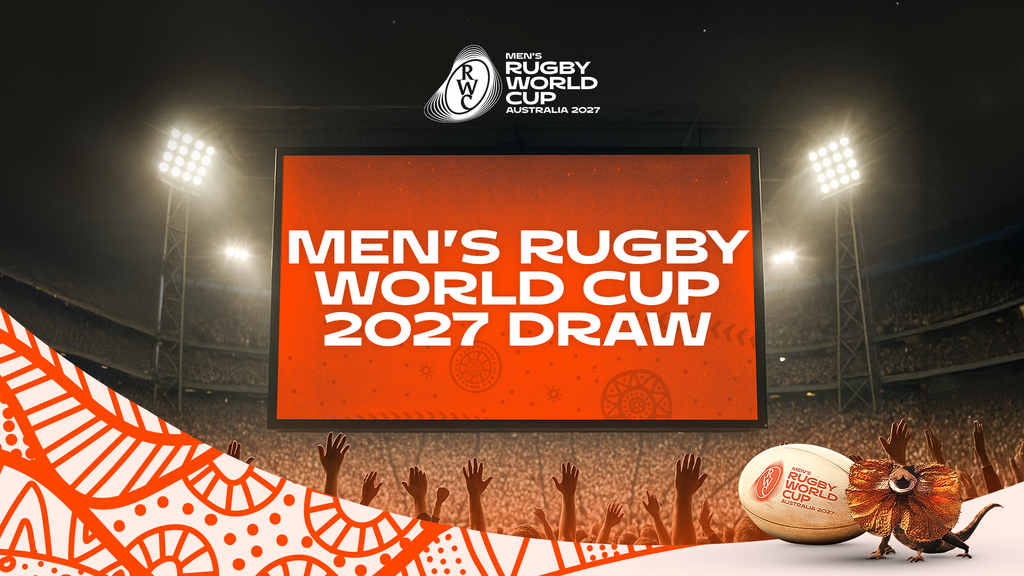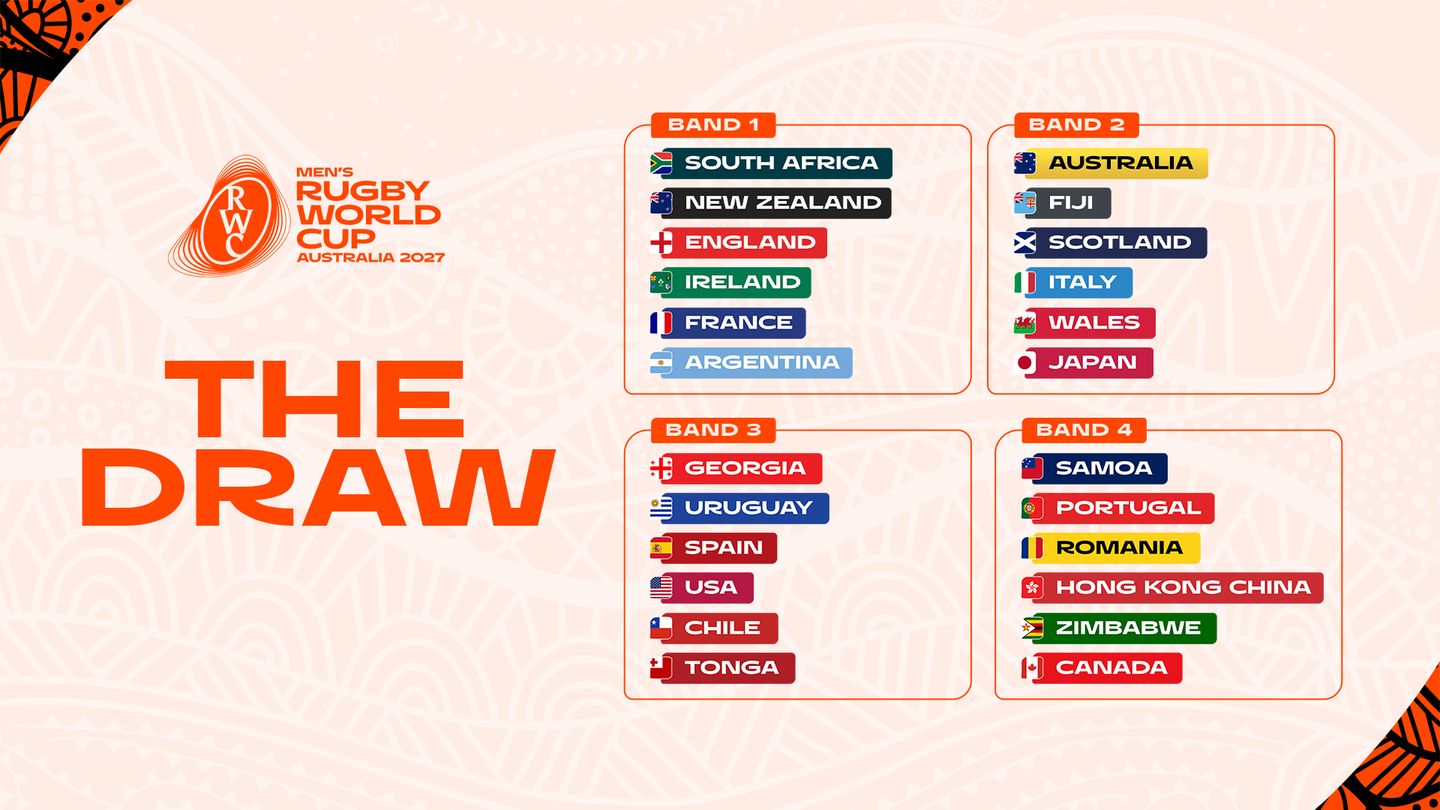Men's Rugby World Cup 2027 will be the biggest tournament in the sport's history, with 24 teams battling it out for the Webb Ellis Cup in two years' time.
Australia will get things underway in the opening game at Perth Stadium on 1 October 2027, kickstarting a new era for a Men's Rugby World Cup. But how does it all work? Marking exactly two years to the day that the tournament will begin, World Rugby has unveiled the format for Rugby World Cup 2027.
In previous tournaments going back to Rugby World Cup 2003, we have traditionally had 20 teams that were divided into four pools of five teams. The top two teams from each pool would then progress to the quarter-finals, which was the first round of the knockouts.
At Australia 2027 we will have 24 teams, and therefore the tournament requires a new format and one big change: a Round of 16 as the first knockout game.
What is the format?
There will now be six pools with four teams in each. The top two teams from each pool will progress to the Round of 16, while the four best third-place teams will also progress. Those four teams will be determined by competition points firstly, and if that doesn't separate the sides then points difference and try difference will be the next factors used respectively to determine which teams make it out of the pool stage.
With an extra round of knockouts, does that mean more games?
For the fans, yes! Instead of 48 matches like we had at the last Men's Rugby World Cup, we now have 52 games. But crucially, it does not equate to more games for the players. With player welfare at the forefront of decisions made around the tournament's structure, World Rugby has adopted this format to ensure maximum jeopardy, drama and excitement for the teams as well as spectators, while not compromising on the health of those who play the game. Five minimum rest days will be observed between matches in Australia.
While we have more knockout matches, the change from five teams in each pool to four has meant one fewer match for each team in the pool stage. For example, when South Africa won Rugby World Cup 2023, they played seven games: four games in the pool stage and a quarter-final, a semi-final and a final. If they were to reach the final of Rugby World Cup 2027, they would still only play seven games: three games in the pool stage, then Round of 16, a quarter-final, a semi-final and a final.
But fans still get four extra matches, and as an added bonus, having an even number of teams in each pool means no team has to sit out a round while the others play each other. So, despite adding four extra teams, the pool stage is now in fact shorter. While Rugby World Cup 2023 lasted 50 days in total, Rugby World Cup 2027 will take place over 43 days (6 weeks). It will therefore be a more condensed and exciting tournament, without adding to the players' workload.
How will the Round of 16 work?
In previous formats, the quarter-finalists would just be the winners of each pool against the runners-up of another pool. With six pools feeding 16 spots in the first round of the knockouts, that requires some changes. First, have a look at this graphic which shows the road to the final:
As you can see, the teams that finish top of Pool A, B, C and D will face a third-place team in the Round of 16, while the teams that finish top of Pool E and F will face teams that finished second in their pool. Likewise, some teams that finished second in their pool may face the winner of another pool, while some will face the runners-up.
While on the surface that may seem slightly unfair, that imbalance is addressed in the next round. Let's take Pool A and Pool E as an example. The team that wins Pool A will face a third-place team in the Round of 16, but in the quarter-finals could potentially meet the winner of Pool B if that team wins their Round of 16 match.
On the other hand, the team that wins Pool E will face a runner-up rather than a third-place team in the Round of 16, but in the quarter-finals would face the winner of a quarter-final between two other runners-up. So while the winner of Pool A would face a third-ranked team and then potentially a top-ranked team in their games, the winner of Pool E would face second-ranked teams in both games. There's therefore no advantage or disadvantage to be gained or lost regardless of your team's raking at the end of the pool stage, it will all even out in the end.
Who will my team face in the pool stage?
That will all be decided on Wednesday, 3 December! The draw will take place in Sydney and will be broadcast on Channel Nine in Australia, but will also be available everywhere on the planet through other international broadcasters as well as online on RugbyPass TV.
Which teams have qualified?
The 12 teams that finished in the top three of their pools at Rugby World Cup 2023 have automatically qualified for Rugby World Cup 2027. Those teams are: France, New Zealand, Italy, Ireland, South Africa, Scotland, Wales, Fiji, Australia, England, Argentina and Japan.
The 12 remaining places were reserved for teams that qualified through various regional tournaments, including this year's Rugby Europe Championship and Rugby Africa Cup. These teams are: Georgia, Spain, Romania, Portugal, Tonga, Canada, United States, Uruguay, Chile, Samoa, Zimbabwe and Hong Kong China.
How does the draw work?
The World Rugby Men’s Rankings at the end of the November internationals will be used to create four bands of six teams, with each band drawn randomly into Pool A, B, C, D, E or F.
There is only one exception to all this: Australia already know they are in Pool A as they are host nation and will therefore contest the opening game on 1 October 2027. The Wallabies are currently in Band 2, which means a team from Band 1 will be drawn and placed in Pool A, and they would automatically be joined by Australia.
Where will the games be played?
With the new format there will be 52 games at Rugby World Cup 2027, an increase from the 48 we saw at Rugby World Cup 2023. The games will be shared between seven iconic Australian cities: Adelaide | Tarntanya, Brisbane | Meeanjin, Melbourne | Narrm, Newcastle | Awabakal-Worimi, Perth | Boorloo, Sydney | Gadigal and Townsville | Gurambilbarra.
Discover Australia 2027's host cities >>
When can I buy tickets?
The RWC 2027 ticket Presale is fast approaching. It will open on 18 February, 2026 at 12:00 AEDT, giving fans the first opportunity to secure tickets before they go on general sale. Presale access is limited to fans who have completed their ticketing account registration by 12:00 AEDT on 17 February, 2026. All matches and all price categories will be available during this Presale.
Full ticketing information here>>
'Rivalries will be set'
World Rugby Chair, Brett Robinson, said: “With only two years until the biggest Men’s Rugby World Cup ever, I’m thrilled to see the tournament draw date revealed. The draw brings the potential match-ups to life, rivalries are set and fans across the globe can envision the unforgettable rugby that awaits.
“Expanding Men’s Rugby World Cup to 24 teams is a landmark moment for our sport. It means more nations, more matches, and more opportunities for fans around the world to connect with rugby.
“The introduction of a round of 16 will deliver even more knockout rugby, ensuring every match counts and every team has the chance to make history. Importantly, we’ve been able to achieve this within a streamlined tournament window that protects player welfare while enhancing the spectacle. This is a huge step forward for rugby and a reflection of the game’s global growth.”









